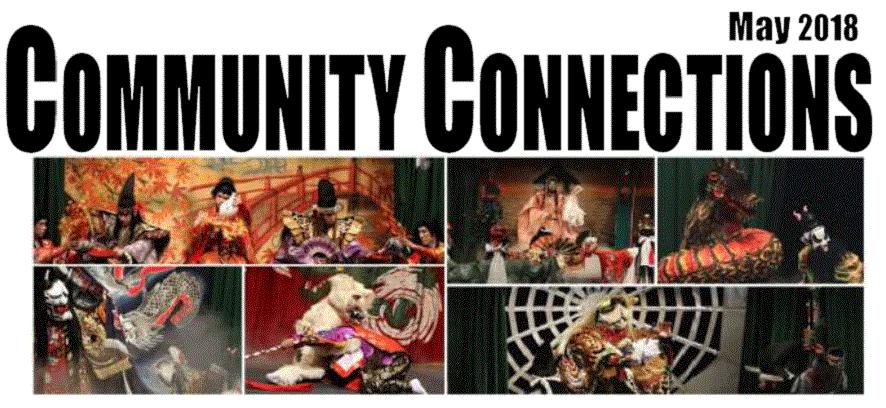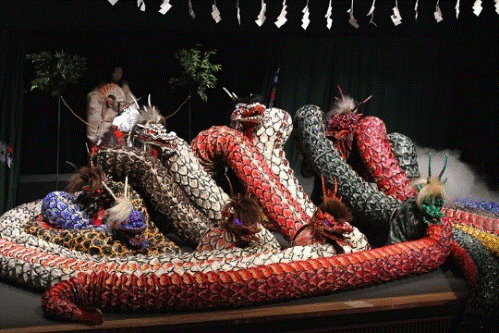 Community Connections
- May 2018
Community Connections
- May 2018
Community Connections is a column written by a Hiroshima City CIR, in which ways of making connections with people or local communities are introduced.
What is a C.I.R. (Coordinator for International Relations)?
A Coordinator for International Relations, or CIR for short, is a participant on the JET Programme who assists local government offices in international exchange at the local level.
KAGURA – DANCING WITH THE DEITIES
By Andrew Dempster

A top an overturned tub and with a branch of the sacred sakaki tree in hand, Ame-no-Uzume, (the Shinto goddess of dawn, mirth and revelry) danced ecstatically, stomped her feet and revealed herself to the feverish amusement of the other gathered kami (gods), who laughed and reveled at the sight. This peaked the curiosity of the sun goddess Amaterasu, who had shut herself away in a rock cave of heaven after her brother Susanoo-no-Mikoto’s infuriating misdeeds. Upon doing so the world was plunged into darkness.
Intrigued by the commotion outside, Amaterasu opened the cave door and was met with boisterous singing and laughter. With the cave finally open, the gathered kami had the perfect opportunity to grab the sun goddess and restore life-giving sunlight to the world.
The kami’s clever ploy to entice Amaterasu out of hiding is recounted in the Kojiki (Records of Ancient Matters, c.712 CE) and the Nihongi (Chronicles of Japan, 720 CE). Despite differing details, both versions of this tale state that it was a result of Ame-no-Uzume’s wild dancing that Amaterasu emerged from the cave.
This tale is hailed as the origin of Kagura. Meaning “god-entertainment (神楽)”, Kagura is a ceremonial dance said to be rooted in shamanic possession rites apparently derived from the events described above. It predates Noh theatre and has had a particular influence on other forms of dance and theatre styles, such as Kabuki. There are many variations that have since evolved, from highly ritualistic miko-kagura, to highly theatrical sato-kagura.
It continues to flourish all over Japan, but perhaps more so in Hiroshima and Shimane Prefectures.
Kagura centres around powerful dances set to rhythmic music performed by flutes and taiko drums, and chanting, with stories drawing on Japanese myths and legends, pitting good against evil; man against demon. With plot twists and big reveals, passionate battles and heartbreak, Kagura is folk culture gold. It features stunning handcrafted masks made from Japanese sekishu-washi paper, immense wigs, elaborately designed handmade costumes, and in plays such as Yamata-no-Orochi, props for an eight-headed serpent! Kabuki-esque stagecraft tricks, such as costume quick-changes (hayagawari), will leave you bewildered.

Eight-headed serpent in Yamata-no-Orochi
From April 4 to December 26, there will be Kagura performances held most Wednesdays at the Hiroshima Prefectural Citizen’s Culture Center. Tickets go on sale on the day of the performance from 17:30, with doors opening at 18:00. Performances start at 19:00 and usually last until around 20:45. Tickets cost ¥1,000. The Prefectural Art Museum also hosts regular performances of Hiroshima Kagura specifically for overseas visitors that feature an introduction in English, a screen next to the stage with a simple summary of each act, and an interpreter who will help with the Q&A session at the end. Moreover, if you’re planning a day trip, consider Kagura-Monzen-Toji-Mura located in the Akitakata district of northern Hiroshima, which is shrouded in the mystical and ancient and famous for its weekly performances of Kagura.

 [pdf,247KB,1page]
[pdf,247KB,1page]